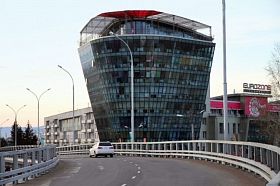
Улан-Удэ отложил выплату кредита Бурятии
Городской долг за развязку в центре столицы выплатят к 2034 году

Городской долг за развязку в центре столицы выплатят к 2034 году

Историческая и духовная реликвия республики требует срочного ремонта

Такое неутешительное заключение сделал Бурятстат

Проезд на одной самых оживленных улиц столицы ограничат из-за теплотрассы

Работы на автотрассах столицы Бурятии начнутся в апреле

Мужчины были пойманы на вокзале с грузом наркотиков

Экипаж и медики справились с задачей на «отлично»

Автор обращения призывает полностью остановить промысел байкальского тюленя

ЧП произошло на станции Наушки в вагоне международного поезда

С давних времён существуют разные традиции, связанные со свадебными церемониями

Казань сегодня можно свободно назвать одним из наиболее прогрессивных в своем развитии городов России. Казань удивительна

Спасатели обучали школьников мерам безопасности

По факту ЧП возбуждено уголовное дело
Light and dark Проводите время в социальных сетях с пользой для себя и своих друзей: #конкурс #ДляДевушек #ДангинаИнформПолис #ЗаявиОсебе We respect execution «Информ Полис» запускает конкурс для тех, кто часто сидит в соцсетях и любит делиться своими фото с друзьями. Каждый день, листая френд-ленту, мы видим десятки фотографий.Почему бы в преддверии светлого праздника Сагаалган не наполнить ее интересными и полезными фактами празднования Нового года по лунному календарю?! Ваши друзья и подписчики узнают вас с новой стороны, благодаря вам пополнят свои знания о бурятской культуре. Ну а вас ждут лайки, восторженные комментарии и - внимание! - вполне возможно, именно вашу фотографию и историю опубликуют в «Информ Полисе». А если вы станете «самой-самой», то получите ценный приз на сумму 10 тысяч рублей. 1 Perceptual Cause and Effect Lighting creates the 2D pattern of contrast the brain interprets to recognize 3D objects in photographs. In an in-person viewing experience the brain relies on stereoscopic vision, parallax, shifting focal in addition to the clues created by the highlight and shadow patterns the light on the object creates. When viewing a photo the brain tries to match the patterns of contrast and color it seen to those other sensory memories. «The baseline for what seems "normal" in lighting is the direction and character of natural and artificial sources and the context provided by other clues» Steve Jobs Apple CEO 2 The Natural Light Baseline To differentiate that role from that of "key" modeling when a modeling source moves behind the object it is typically called a "rim" or "accent" light. In portrait lighting it also called a "hair" light because it is used to create the appearance of physical separation between the subject's head and background. When a photographer puts the sun behind an object its role in the lighting strategy changes from modeling the front of the object to one of defining its outline and creating the impression of physical separation and 3D space a frontally illuminated scene lacks. Steve Jobs Apple CEO 1818 Magazine by Stephanie Toole To differentiate that role from that of "key" modeling when a modeling source moves behind the object it is typically called a "rim" or "accent" light. In portrait lighting it also called a "hair" light because it is used to create the appearance of physical separation between the subject's head and background. 3 Creating Natural Looking Artificial Lighting A typical studio lighting configuration will consist of a fill source to control shadow tone, a single frontal key light to create the highlight modeling clues on the front of object facing the camera over the shadows the fill illuminates, one or more rim/accent lights to create separation between foreground and background, and one or more background lights to control the tone of the background and separation between it and the foreground. There are two significant differences between natural lighting and artificial sources. One is the character of the fill and the other is more rapid fall-off in intensity. In nature skylight fill is omni-directional and usually brighter from above. That "wrap around" characteristic is difficult to duplicate with a directional artificial source.
Банк ВТБ получил статус члена-участника Шанхайской Биржи Золота ("SGE") с правом участия в торгах на международном отделении биржи в зоне свободной торговли Шанхая
27 октября состоялась первая онлайн-конференция для держателей акций банка ВТБ

В День народного единства в столице Бурятии пройдут бесплатные концерты

Координатор проекта попросила поддержку у горсовета Улан-Удэ

Предстоящий уикенд порадует жителей столицы Бурятии

От «Toyota Land Cruiser 200» остался только обгоревший каркас
Официальную делегацию от Торгово-промышленной палаты Республики Бурятия возглавит Президент ТПП РБ – Игорь Иванович Зураев

Убив сожительницу, мужчина спокойно допил коктейль и ушел

Однако запрет на Хэллоуин, по мнению чиновников, это все-таки «крайняя мера»

А в пригороде столицы Бурятии полиция нашла «наркоозеро»

Юные журналисты изучили СМИ и вынесли свой вердикт

Москва дала «зелёный свет» на строительство мусороперерабатывающего завода в Улан-Удэ

На берегу прибайкальской речки нашли растерзанных тюленей

Республика не может освоить федеральные средства на туризм

23 октября на участке федеральной дороги «Южный Байкал» в Слюдянском районе досрочно закончился ремонт полотна с устройством дополнительных полос «на подъем» на опасных «байкальских серпантинах»

Чтобы выжить, женщины зашивали в складки тела золото

«Фронтовики» раскритиковали идею Наговицына

Полет в Москву обойдется дороже, чем отпуск в тропиках

Скидка распространяется на украшения из золота с ювелирными цветными камнями, в том числе на камень-хамелеон султанит

КВН-щики и борец Богомоев пронумеруют частный сектор

Дошкольники Улан-Удэ узнали всю правду о главе Бурятии и мэре города

Откровенное интервью о VIP-пенсиях и автомобилях с водителем

Энергослужбы сдались: семью Кабаковых из Бичурского района молча подключили к электричеству

Штрафовать начнут уже с января будущего года
Будьте спокойны, мы никому не покажем ваши данные.